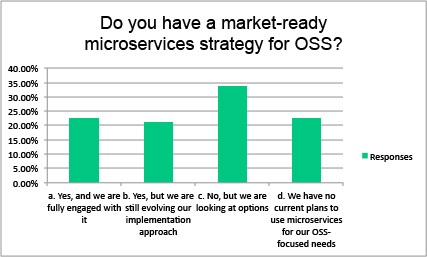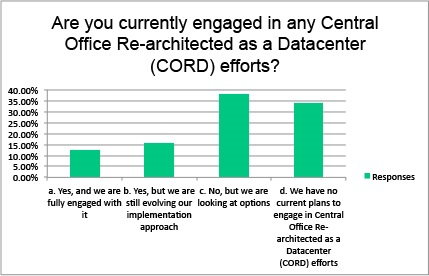Analysts Frost & Sullivan collaborated with VanillaPlus recently to ask our readers their thoughts on 10 key questions facing communication service providers (CSPs) involved in digital transformation of their business and operations. In a 2-part summary, Jeremy Cowan reports on the findings.
We had responses from 71 CSPs worldwide and so we shared these results with VanillaPlus’ independent Editorial Advisors for their insight, talking to senior figures within Huawei, Openet and Sigma Systems. The first question was, Do you have a market-ready microservices strategy for OSS (operations support systems)?

| Answer Choices | Responses | |
| a. Yes, and we are fully engaged with it | 22.54% | 16 |
| b. Yes, but we are still evolving our implementation approach | 21.13% | 15 |
| c. No, but we are looking at options | 33.80% | 24 |
| d. We have no current plans to use microservices for our OSS-focused needs | 22.54% | 16 |
Logically therefore, Question Two was going to be, Do you have a market-ready microservices strategy for BSS (business support systems)?
| Answer Choices | Responses | |
| a. Yes, and we are fully engaged with it | 30.99% | 22 |
| b. Yes, but we are still evolving our implementation approach | 16.90% | 12 |
| c. No, but we are looking at options | 30.99% | 22 |
| d. We have no current plans to use microservices for our BSS-focused business needs | 21.13% | 15 |
Catherine Michel, CTO of Sigma Systems says, “Whether considering an OSS platform or a BSS platform, micro-services have a key role to play in the interoperability of systems and networks as service providers upgrade to more agile, dev-ops compatible infrastructures. But like with any new buzz word, such as machine learning, big data, digitalisation, one must be careful not to get caught up in the hype.
“Micro-services easily run the risk of being so granular as to not add any true value as architectural or business function. Instead, as with Sigma’s approach, micro-services must adhere to the notion that each service is a valid business capability that is independently deployable through a fully automated process. Anything less and you’ve missed the value of what is really the next evolution of a service-oriented architecture (SOA),” says Michel.

Martin Morgan, vice president of Marketing at Openet, tells VanillaPlus, “There’s a couple of very clear results that stand out for me. First is the adoption of microservices in BSS (business support systems). The high number of operators who are using or are planning to use microservices indicate the key business benefits that microservices in BSS can bring.”
“For years, the IT teams in operators have been getting beat up by the marketing teams who are looking for BSS to support the latest marketing idea and offers. Traditional ways of supplying BSS with large, expensive projects, that took forever to complete just won’t work in the current webscale business climate that telcos are moving into. Microservices can enable faster, smaller, more agile solutions, that can enable telcos to cherry pick the functions they need and prioritise the projects that will deliver the most value. This could even provide a way for IT to keep the marketing teams happy.”
In Question Three we asked, How confident are you that management silos can be eliminated in hybrid physical/virtual networks in order to create a unified view and management capability?

Catherine Michel says, “Innovation in the networks will do nothing to remove management silos. In fact, for years to come, that innovation will only add to the complexity of the network landscape as it co-exists with traditional networks.”
“Only transformation of the operational infrastructure that defines, manages and orchestrates what happens on the networks will deliver that rationalisation. Catalog-driven, agile B/OSS is what is required to effect this transformation.”

Question Four was, Are you currently engaged in any Central Office Re-architected as a Datacenter (CORD) efforts?
The results showed only a quarter of CSPs (28%) are currently engaged with CORD or are eveloping their approach to CORD implementation.
| Answer Choices | Responses | |
| a. Yes, and we are fully engaged with it | 12.68% | 9 |
| b. Yes, but we are still evolving our implementation approach | 15.49% | 11 |
| c. No, but we are looking at options | 38.03% | 27 |
| d. We have no current plans to engage in Central Office Re-architected as a Datacenter (CORD) efforts | 33.80% | 24 |
In Question Five we wanted to know, How significant an advantage does AT&T have with its “first to market” ECOMP virtual network platform, through which other CSPs can connect? The answer came back strongly (more than 83%) believe that AT&T has an advantage from its platform.

| Answer Choices | Responses | |
| a. Immaterial. All major carriers will develop their own platforms | 16.90% | 12 |
| b. Somewhat significant. AT&T learns valuable lessons, gains significant mindshare | 43.66% | 31 |
| c. Significant. AT&T puts itself in a position to influence the direction of industry development | 25.35% | 18 |
| d. Very Significant. AT&T becomes the leader in digital service delivery and multi-party, cross-industry solutions | 14.08% | 10 |
Part 2 of this article will be published on Thursday, October 19th.
Comment on this article below or via Twitter: @VanillaPlus OR @jcvplus






